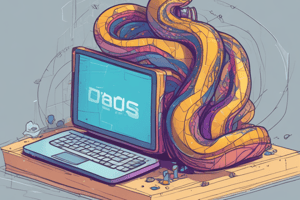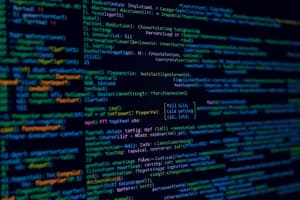Podcast
Questions and Answers
What is the primary purpose of using a template engine like Jinja2 or Mustache?
What is the primary purpose of using a template engine like Jinja2 or Mustache?
- To store data in a database
- To separate presentation logic from application logic (correct)
- To create plots and charts for data visualization
- To perform numerical computations
What type of data structure is supported by the Pandas library?
What type of data structure is supported by the Pandas library?
- Only 3D arrays
- Only matrices
- Only graphs
- 1D and 2D data structures (correct)
What is the primary use of ORM tools in web development?
What is the primary use of ORM tools in web development?
- To interact with databases (correct)
- To create templates for web pages
- To create machine learning models
- To perform data analysis and visualization
What is the primary purpose of the Scikit-learn library?
What is the primary purpose of the Scikit-learn library?
What is the primary purpose of HTTP responses in web development?
What is the primary purpose of HTTP responses in web development?
What is the main difference between a list and a tuple in Python?
What is the main difference between a list and a tuple in Python?
What is the primary purpose of a dictionary in Python?
What is the primary purpose of a dictionary in Python?
What is the benefit of using inheritance in object-oriented programming?
What is the benefit of using inheritance in object-oriented programming?
What is the primary difference between Flask and Django, two popular web frameworks in Python?
What is the primary difference between Flask and Django, two popular web frameworks in Python?
What is the purpose of the requests and responses in web development?
What is the purpose of the requests and responses in web development?
Flashcards are hidden until you start studying
Study Notes
Data Structures
- Lists:
- Ordered collection of items
- Can be modified (mutable)
- Indexing starts at 0
- Supports slicing, concatenation, and indexing
- Tuples:
- Ordered, immutable collection of items
- Faster than lists, but cannot be modified
- Useful for storing data that shouldn't change
- Dictionaries:
- Unordered collection of key-value pairs
- Keys must be unique, immutable, and hashable
- Values can be of any type, including mutable
- Sets:
- Unordered collection of unique items
- Fast membership testing and insertion
- Supports union, intersection, and difference operations
Object-oriented Programming
- Classes:
- Define a blueprint for creating objects
- Contain attributes (data) and methods (functions)
- Can inherit behavior from parent classes
- Objects:
- Instances of classes
- Have their own attributes and methods
- Can be manipulated independently
- Inheritance:
- Mechanism for creating a new class from an existing class
- Child class inherits attributes and methods from parent class
- Can also override or extend parent class behavior
- Polymorphism:
- Ability of an object to take on multiple forms
- Can be achieved through method overriding or method overloading
Web Development
- Flask and Django:
- Two popular web frameworks for building web applications
- Flask is a microframework, Django is a full-featured framework
- Requests and Responses:
- HTTP requests: GET, POST, PUT, DELETE, etc.
- HTTP responses: status codes, headers, and bodies
- Templates:
- Use template engines like Jinja2 or Mustache to render dynamic content
- Separate presentation logic from application logic
- Databases:
- Use databases like MySQL, PostgreSQL, or SQLite to store data
- Interact with databases using ORM (Object-Relational Mapping) tools
Data Analysis
- NumPy:
- Library for efficient numerical computation
- Supports arrays, matrices, and mathematical operations
- Pandas:
- Library for data manipulation and analysis
- Supports data structures like Series (1D) and DataFrames (2D)
- Provides data filtering, grouping, and merging capabilities
- Matplotlib and Seaborn:
- Data visualization libraries
- Create plots, charts, and graphs to visualize data
- Scikit-learn:
- Library for machine learning
- Provides algorithms for classification, regression, clustering, and more
- Supports data preprocessing, feature selection, and model evaluation
Data Structures
- Lists:
- Ordered collection of items that can be modified
- Indexing starts at 0, supports slicing, concatenation, and indexing
- Tuples:
- Ordered, immutable collection of items, faster than lists
- Useful for storing data that shouldn't change, cannot be modified
- Dictionaries:
- Unordered collection of key-value pairs, keys must be unique, immutable, and hashable
- Values can be of any type, including mutable
- Sets:
- Unordered collection of unique items, fast membership testing and insertion
- Supports union, intersection, and difference operations
Object-oriented Programming
- Classes:
- Define a blueprint for creating objects, contain attributes (data) and methods (functions)
- Can inherit behavior from parent classes
- Objects:
- Instances of classes, have their own attributes and methods
- Can be manipulated independently
- Inheritance:
- Mechanism for creating a new class from an existing class
- Child class inherits attributes and methods from parent class, can also override or extend parent class behavior
- Polymorphism:
- Ability of an object to take on multiple forms, can be achieved through method overriding or method overloading
Web Development
- Flask and Django:
- Two popular web frameworks for building web applications, Flask is a microframework, Django is a full-featured framework
- Requests and Responses:
- HTTP requests: GET, POST, PUT, DELETE, etc.
- HTTP responses: status codes, headers, and bodies
- Templates:
- Use template engines like Jinja2 or Mustache to render dynamic content
- Separate presentation logic from application logic
- Databases:
- Use databases like MySQL, PostgreSQL, or SQLite to store data
- Interact with databases using ORM (Object-Relational Mapping) tools
Data Analysis
- NumPy:
- Library for efficient numerical computation
- Supports arrays, matrices, and mathematical operations
- Pandas:
- Library for data manipulation and analysis
- Supports data structures like Series (1D) and DataFrames (2D)
- Provides data filtering, grouping, and merging capabilities
- Matplotlib and Seaborn:
- Data visualization libraries, create plots, charts, and graphs to visualize data
- Scikit-learn:
- Library for machine learning
- Provides algorithms for classification, regression, clustering, and more
- Supports data preprocessing, feature selection, and model evaluation
Studying That Suits You
Use AI to generate personalized quizzes and flashcards to suit your learning preferences.




